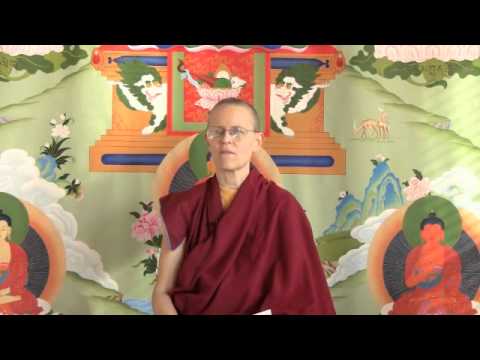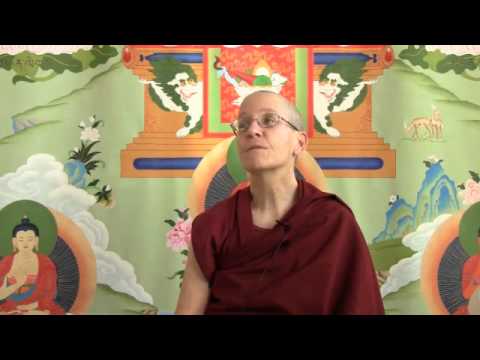The power of reliance: Refuge
Part of a series of teachings given at the Winter Retreat from December 2011 to March 2012 at Sravasti Abbey.
- The order of the four opponent powers
- Our dependence upon both holy and sentient beings for awakening
- The causes of refuge
- Why Vajrasattva is a reliable source of refuge
- Guided visualization
Vajrasattva 12: The power of reliance: Refuge (download)
We’re going to start on the Vajrasattva practice or sadhana. Over the next few weeks we’ll go through it verse by verse. Today I’m going to start with the opponent power of reliance, which is the first one of the four opponent powers in this practice. It’s been really wonderful thinking about this. It’s been a lot to chew on over the past two weeks.
It’s interesting, because when Venerable Tarpa shared the four opponent powers a few days ago, she put them in a slightly different order. I don’t think it matters over the long haul. Sometimes regret is first. Geshe Sopa’s text has reliance as the fourth opponent power when he teaches it in his lamrim commentary. But here it’s in the first position. I happen to think that it’s a marvelous position for it to be, because here we are doing this extremely powerful, intended practice. At the end of the practice when we make that determination to refrain from doing these destructive actions (for however long) I personally want to know where I’m going to go to make another decision. By putting the taking refuge and generating the altruistic intention up in front, we’ve got that sort of direction already lined out within our own minds before we go through this very powerful practice with the other four opponent powers.
The other thing that I find really quite amazing about refuge and bodhicitta, it’s sort of like the ground, in that we stumble and fall when we continually harm them, disrespect them, forget about them. At the same time it is in dependence upon our relationship to them that our awakening happens. So there’s this extraordinary relationship that we always have to remind ourselves, that if we’re going to become awakened, our relationships to holy beings and to sentient beings must be on a very solid, loving, clear, open ground.
How do we do that? First, we have to—and once again we’re going to go over the causes for refuge because they are so crucial. As Venerable Samten said last week, we’ve got to cultivate this wisdom fear. We’ve got to be willing to look at our situation here in samsara in a very forthright, direct, honest, and open way; and to realize that our bodies and minds are out of control. We have no control over them; they get old, they get sick, they die. The afflictions arise, we are propelled through life after life, totally out of control—and the rest of the universe, as a matter of fact, is also out of our control. Suffering occurs because of our continual effort to try to bring it under our control. Its nature is dukkha: dissatisfactoriness. It’s unstable, it’s uncertain, it’s impermanent, and the suffering is caused by just wanting it to be other than that. We have to realize at various levels what’s happening; and that we really get frustrated and get fed up enough to start generating this disgust for cyclic existence. Then turning to, “Who are we going to have to help us get out of this mess?”
Now, without the wisdom fear, we can fall into this habit of despair and despondency about our situation. As Venerable Chodron says, we can imagine ourselves being in this lonely, cold universe with only our karma, our afflictions, and our suffering as our friends—which doesn’t sound very appealing. But, she says, we have to remember that the universe is filled with buddhas, and that their total reason for existence is to benefit us. We have to really take that as a truth. When she was teaching this last year in Vajrapani Institute this is the part that really struck me so much. She said we have to remember that buddhas have not always been buddhas. They haven’t. Bodhisattvas haven’t been bodhisattvas. Vajrasattva hasn’t always been Vajrasattva. They’ve been on the beach, having tea with us, through countless eons, under the control of afflictions and karma, propelled by their karma, rebirth after rebirth.
Somewhere along the line, and we don’t know when, we parted company. They found the path, and with incredible determination and joyous effort practiced it purely and became buddhas. Here we are still running around in circles in cyclic existence. Luckily for us, because they did it based on this incredible wish to benefit and through our own virtuous karma, we get to meet Vajrasattva again. Totally different relationship, you know? Totally different meaning of what ‘friend’ is.
The other thing to understand is that buddhas don’t practice other paths. It’s not like there’s this Buddha path they practice, and then there’s us little ordinary beings that practice our path. Vajrasattva is who he is because he practiced the path that we are walking at this very moment! We have to always remember that. They were dependent arisings, came from the realm of ordinary beings, practicing the exact path that we’re on. For me, Vajrasattva is reliable for this very reason. He knows what we are up against. He knows the pitfalls. He knows that self-centered thought is a thief in the night. He knows that the hallucinations of the self-grasping ignorance trick us over and over again to convince us that what appears is how things exist. We’re caught in that over and over again. He knows it—he knows how we get hooked.
That’s where this incredible compassion arises in Vajrasattva’s mind. This is because he sees the suffering over and over again by these misunderstandings, being dragged through samsara with the self-centered thought and the self-grasping ignorance. At the same time he’s got the wisdom realizing emptiness that understands how things actually exist. In the deepest sense of word, he sees how needless and how unnecessary it is. And so, he’s in it for the long haul with us.
For me Vajrasattva is an extremely reliable guide. They’re the best because they found the way by following the correct path. They know it like the back of their hands. He knows the difficult places. He knows where it gets tough. He knows where we can go off. But his commitment to sentient beings is that he will never deceive, he will never mislead us, and he will never lie to us. I don’t know about you, but a reliable guide for a long journey like this is somebody who’s been there and done that, and knows how to go.
Despite his compassion and his wisdom and wanting to help, we continually lose sight of him. The whole part about this restoring relationship is that we’re continually losing sight of his compassion, his direction, his guidance. We take refuge in worldly things. One of the ways that we really harm that relationship is that we use the Dharma to feed our sense of self-importance. This is where we get into this disrespecting, this thoughtlessness around holy objects, which are symbols and representations of the Buddha’s body, speech, and mind. We wheel and deal on e-bay and Amazon to get the most beautiful statue for the best price that will, “Go perfectly with my altar.” You know, it’s out there. The consumer mind of acquisition harms our relationship to the Three Jewels. If we buy these beautiful objects because we know much how they are going to inspire us—to remind us of our potential—then they are wonderful things to have in our lives. But we have to be very careful that we don’t use it to just feed the self-centered thought and the self-grasping at inherent existence.
By restoring a relationship with the holy beings, it’s a continual practice of remembering our own potential, to remember that Vajrasattva is indeed a reliable guide. As I go through the visualization, try to imagine Vajrasattva as somebody who knows so deeply and so clearly the correct way to go that we can put our entire trust and confidence in his capacity to lead us clearly without error. Then it’s up to us. One of the things he wants to encourage—knowing our buddha potential—is for us to grow our own wisdom, our own confidence so that as time goes on, we can catch the thief. We can catch the hallucination when it gets conjured up by the self-grasping ignorance and be able to catch it more and more, sooner and sooner. Remember our refuge. Remember the path.
Vajrasattva (to try to imagine) is very close to us. He’s a deep friend, a reliable trustworthy guide with impeccable credentials. Put him on the crown of our head. As I go through the visualization try to bring him as close as you can in your heart.
Visualization
Here is this incredible reliable guide, sitting about four inches above the crown of our heads, on an open white lotus—symbolizing renunciation and the determination to be free, and a moon disc—symbolizing bodhicitta. There he sits. His body is made of light—as a result of all those eons of merit he accumulated his beautiful form body that he has—and it is clothed in celestial silks. His two hands are crossed at his heart. The right hand holds a vajra, the left hand holds a bell—the union of bliss and emptiness. At his heart is a moon disc with the seed syllable HUM and at the moon disc’s center. The letters of his hundred syllable mantra stand clockwise around the moon’s edge. As we hold Vajrasattva in mind, we gently dissolve him into light and bring him down to our hearts; most trustworthy, most compassionate, most wise, kind friend.
[As I’m giving this talk right before lunch we’ll next make our food offering.] As we do our food offering, imagine that we make the offering to this wonderful reliable guide at our hearts. Rejoice that we have met once again and take his wisdom quite seriously onto the path.
Venerable Thubten Semkye
Ven. Semkye was the Abbey's first lay resident, coming to help Venerable Chodron with the gardens and land management in the spring of 2004. She became the Abbey's third nun in 2007 and received bhikshuni ordination in Taiwan in 2010. She met Venerable Chodron at the Dharma Friendship Foundation in Seattle in 1996. She took refuge in 1999. When the land was acquired for the Abbey in 2003, Ven. Semye coordinated volunteers for the initial move-in and early remodeling. A founder of Friends of Sravasti Abbey, she accepted the position of chairperson to provide the Four Requisites for the monastic community. Realizing that was a difficult task to do from 350 miles away, she moved to the Abbey in spring of 2004. Although she didn't originally see ordination in her future, after the 2006 Chenrezig retreat when she spent half of her meditation time reflecting on death and impermanence, Ven. Semkye realized that ordaining would be the wisest, most compassionate use of her life. View pictures of her ordination. Ven. Semkye draws on her extensive experience in landscaping and horticulture to manage the Abbey's forests and gardens. She oversees "Offering Volunteer Service Weekends" during which volunteers help with construction, gardening, and forest stewardship.


